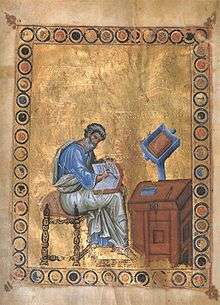Minuscule 585
Mimuscule 585 (in the numbering Gregory-Aland) ε 125 (von Soden)[1] is an illuminated Byzantine Gospel Book. It is dated paleographically to the late 10th-century.[2][3]
| New Testament manuscript | |
 Folio 11v, Portrait of Matthew | |
| Text | Gospels |
|---|---|
| Date | 10th century |
| Script | Greek |
| Now at | Biblioteca Estense |
| Size | 18.4 x 11.7 |
| Type | Byzantine text-type |
| Category | V |
| Note | member of the family Family Kx |
Description
The manuscript contains the four Christian Gospels. Originally there were Evangelist portraits at the beginning of each Gospel, but the portrait of Luke is lost. The text is written on 300 parchment leaves, in one column per page, 20 lines per page.[2]
The tables of the κεφαλαια (tables of contents) are placed before every Gospel, numerals of the κεφαλαια (chapters) are given at the margin, and their τιτλοι (titles) at the top of the pages. There is also a division according to the Ammonian Sections (in Mark 233 Sections, the last in 16:8), with a references to the Eusebian Canons (written below Ammonian Section numbers). It contains liturgical books (Synaxarion, Menologion) and portraits of the Evangelists.[4]
The manuscript is an example of the art during the Macedonian Renaissance.
Text
The Greek text of the codex is a representative of the Byzantine text-type. Aland placed it in Category V.[5] Hermann von Soden classified it to the textual family Family Kx. It was examined by the Claremont Profile Method.[6]
History
It is dated by the INTF to the 10th century.[3]
The manuscript was in Venice in 1560, and was probably purchased by Duke Alfonso II d'Este. It was moved to Vienna in 1589 by Francesco d'Este. In 1868 it was returned to Italy under the provisions of the Convention of Florence.
Currently it is housed at the Biblioteca Estense (Gr. I) at Modena.[3]
See also
- List of New Testament minuscules
- Biblical manuscript
- Textual criticism
References
- Gregory, Caspar René (1908). Die griechischen Handschriften des Neuen Testament. Leipzig: J. C. Hinrichs'sche Buchhandlung. p. 68.
- Aland, K.; M. Welte; B. Köster; K. Junack (1994). Kurzgefasste Liste der griechischen Handschriften des Neues Testaments. Berlin, New York: Walter de Gruyter. p. 81. ISBN 3-11-011986-2.
- Handschriftenliste at the Münster Institute
- Gregory, Caspar René (1900). Textkritik des Neuen Testaments. 1. Leipzig: J.C. Hinrichs. p. 205.
- Aland, Kurt; Aland, Barbara (1995). The Text of the New Testament: An Introduction to the Critical Editions and to the Theory and Practice of Modern Textual Criticism. Erroll F. Rhodes (trans.). Grand Rapids: William B. Eerdmans Publishing Company. p. 139. ISBN 978-0-8028-4098-1.
- F. Wisse, The Profile Method for the Classification and Evaluation of Manuscript Evidence, William B. Eerdmans Publishing, 1982, p. 92.
Further reading
- Crinelli, Lorenzo. Treasures from Italy's Great Libraries. New York, The Vendome Press, 1997.